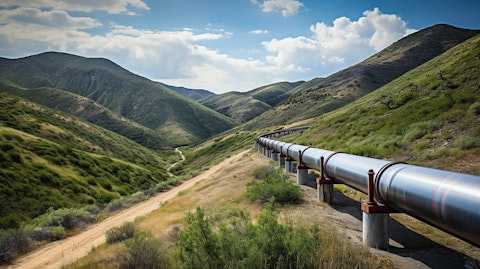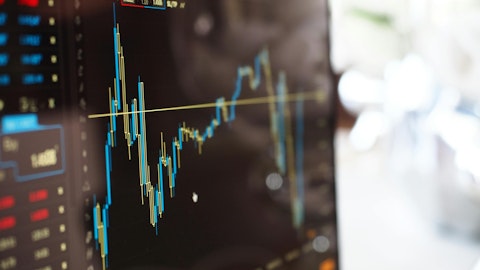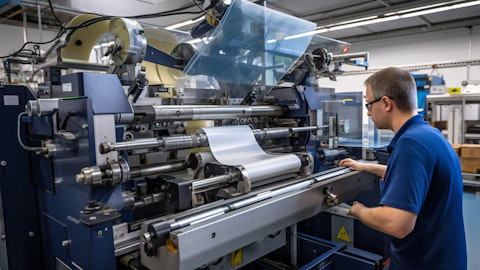Matador Resources Company (NYSE:MTDR) Q1 2025 Earnings Call Transcript April 24, 2025
Operator: Good morning, ladies and gentlemen. Welcome to the First Quarter 2025 Matador Resources Company Earnings Conference call. My name is Tanya, and I will be serving as your operator for today. At this time, all participants are in a listen-only mode. We will facilitate a question and answer session at the end of the company’s remarks. As a reminder, this conference is being recorded for replay purposes, and the replay will be available on the company’s website for one year as discussed in the company’s earnings press release issued yesterday. I will now turn the call over to Mr. Matt Schmidt, Senior Vice President, Investor Relations for Matador. Mr. Schmidt, you may proceed.
Mac Schmitz: Thank you, Latanya, and good morning, everyone, and thank you for joining us for Matador’s first quarter 2025 earnings conference call. Some of the presenters today will reference certain non-GAAP financial measures regularly used by Matador Resources in measuring the company’s financial performance. Reconciliations of such non-GAAP financial measures with the comparable financial measures calculated in accordance with GAAP are contained at the end of the company’s earnings press release. As a reminder, certain statements included in this morning’s presentation may be forward-looking and reflect the company’s current expectations or forecasts of future events based on the information that is now available. Actual results and future events could differ materially from those anticipated in such statements.
Additional information concerning factors that could cause actual results to differ materially are contained in the company’s earnings release, and its most recent annual report on Form 10-Ks, and any subsequent quarterly reports on Form 10-Q. In addition to our earnings press release issued yesterday with the first quarter 2025 earnings release under the Investor Relations tab on our corporate website. And finally, as a reminder, I would like to invite all of you to join us for our first-ever town hall conference call on Monday, April 28th at 3:30 PM Central Time. Please send any questions that you have in advance by email, to investors@matadorresources.com no later than 3 PM Central Time on Friday, April 25th. The live conference call will be available under the Investor Relations tab on our corporate website.
And with that, I would now like to turn the call over to Mr. Joe Foran, our Founder, Chairman, and CEO. Joe?

Joseph Foran: Thank you, Mac. As we have often done in the past, I like to begin by insights in some of the things that we expressed in our earnings release is that the first one is that we have been here before. In challenging times. And we have come out of it each time stronger than we went in. So we have confidence in the plans that we have submitted to you today. We feel we have the right tools in the toolbox that give us the flexibility and the optionality to make the plans work and advance Matador’s interest and value. Regardless of the atmosphere or how much it changes throughout the year. Second is to call to the attention that not only we tried to make the prudent decisions, but can really point to the operational excellence of our field people and our operating staff.
Is that we have had growth in the revenue revenues to a point that we were able to repay $190 million of our debt. We have record gas processing. The Marlin plant is coming online in between the Merlin plant and Black River. We will have processing capacity of 720 million. Which is quite a bit better than the original Black River plant that was only 60 million. So and that provides us a large amount of flow assurance which is critical these times to get all of it you can to market. And finally, the point three is that we wanted the emphasize how we have an alignment of interest with our shareholders. That is one of the reasons that we have the board authorized a repurchase of shares to be sure people knew of that alignment. But second is to point out what we did in the first quarter, what we being the management leadership team that we had over 31 transactions.
Virtually everybody on the management team bought shares, and then we had over 100 other employees buying stock. Where others were not other companies were not as aggressive, but our guys like our leadership team recognize a good deal when they see it. So we felt it was important to offer the opportunity to have a repurchase of shares at this price, we think it is a good buying opportunity and a good entry point. That and so we welcome your questions. And you know, finally, there has been some concern. About production. Is it going up or it is going down? We slowed down a little bit on our production, but it was not because the wells were performing well. They have done better than they expected, but what you had was you had some shut-ins due to maintenance, and in light of that, the maintenance and force majeure events, in light of that, you know, we were off by 1 or 2%, which you know, we could have easily made that up but we was better to move slowly but surely to be sure to provide growth for this year reduce expenses, and to wait for the processing to come online.
So we received the full economic benefit. Of our production. And we will have growth at the end of the year remind everybody that if we are 1% down now, by the end of the year, we will be up 17%.
Mac Schmitz: Latanya, with that, we would like to take a few questions.
Q&A Session
Follow Matador Resources Co (NYSE:MTDR)
Follow Matador Resources Co (NYSE:MTDR)
Receive real-time insider trading and news alerts
Operator: Certainly. After which, we will welcome additional follow-up questions from you. First question will be from Tim Rezvan of KeyBanc Capital Markets. Your line is now open.
Timothy Rezvan: Good morning, folks, and thank you for taking my question. I would like to start on the midstream. Obviously, there has been a lot of volatility in the broader market. They may be impacting the decision on that. You know, you did use the phrase IPO in your fourth quarter earnings deck. We did not see that in this deck. So you talk maybe about, you know, what you are thinking about with the path forward? On the midstream side given you have been pretty candid that you are you are looking to kinda realize value from that segment. Thank you.
Gregg Krug: Yeah. This is Gregg Krug. EVP of marketing and midstream strategy. Yeah. We are looking at all these options as far as possibility of IPOs, and various other things you know, we we are looking at opportunities to to grow our business and know, if we think about you know, kind of where we started, you know, we started at 60 million a day at the Black River plant. And as Joe mentioned, you know, we are at once we get this plant up and going, which is gonna be at this this quarter. Should be we should be up at 720 million a day of capacity. So we like our growth that we are we are seeing now, and we see opportunities to go further. We have got a lot of inquiries on third party gas that that we are that we are chasing, and we think there are lots of opportunities there. So as far as yeah. Your question on IPO, yeah. That is that is always a possibility, and we are investigating all those opportunities.
Operator: And our next question will be coming from Zach Parham of JPMorgan. Your line is open, Zach.
Zach Parham: Thanks for taking my question. Just given the changes in the operational plans, they wanted to talk about how you are thinking about longer term. I mean, historically, Matador has been a growth company. With this guidance update, your your stuck in half implied volumes are are roughly in line with four q oil at a more of a maintenance level. In in the current environment, how are you thinking about the longer term outlook for the company you know, in the current commodity price environment, would you continue at maintenance levels, or would you anticipate anticipate growing again at at some point?
Joseph Foran: Well, thank you, Zach. It is a good question. And and the answer is yes. We are you know, we are very open to and want to have reason to grow again. It is not that we are downsizing now because it is I mentioned, we are gonna have 17% growth in oil production by year end, and this is primarily a timing matter, and is this a temporary thing on oil prices, or is this a new world you live in? And we are gonna do what is profitable. We have never been a growth for growth sake, It is always been our motto here has been profitable growth at a measured pace. And if you you know, mean what you say about a measured pace, that means when prices get a little lower, you are a little more take a few more moments to think about what you are doing.
And do not rush into things. And to manage your your contracts with your vendors so you have optionality and flexibility. To either add or to take down, and you build relationships with them, that give you that kind of flexibility and optionality. So we are very much I intend to grow And we are shareholders too. Nobody here wants to own stock. Unless there is gonna be increases in value over time. And I think we are very well positioned for it because you may say, well, your production was a little bit off this quarter. Yeah. But we paid down $190 million in debt, so that leaves us with a lot of optionality there is to we want to speed up CapEx expenses as the year goes along or We wanna make an acquisition. But either way, we have got the tools in the toolbox, including the share repurchase.
To make Matador more value quarter by quarter. What we do not wanna do is to do it blindly and or to rush in in a time of turbulence. We are gonna do it slow and steady, but that proper growth at a measured pace. Is governor governor govern our approach but we have lots you know, ten to fifteen years of inventory. So there is no shortage of inventory And everywhere we drill these wells, they are gonna have a high net right of return, and it is just optimizing those locations and our field staff and our midstream business, to you know, consistently generate growth and profitability. And if you look at our last you know, since we went public, you see over and over again, we have generated profits per quarter. And we had a profit this quarter.
So I do not know how many straight quarters that makes for it, but it has been very consistent. That we have not had a losing quarter. And and that is because of the professional approach of our office staff, our field staff, and that they have great properties. To work with. The two big acquisitions we made in the last couple of years both of which were about $2 billion did not integrate it. Very smoothly, and the performance has been better than expected. And so pretty excited, and that is why you saw as much buying from insiders as you did, and you can expect it again this quarter. For me, I have never sold a share. And and I have had kids in college for that matter. I am not trying to be flippant, but know, we all have things like that, but this has been where the value is generated.
Rising from we started with 270,000, and we feel we have over $11 billion in assets now. So this group collectively has made good decisions all along and we have encountered these times. Numerous times and we have always come out ahead. If if you may you know, and you can Zach, you have been around long enough to remember those, but each time, we have come out, whether it has been COVID or the BLM leases, that people were worried about, that we paid too much for. But we are paying out at $20 a barrel oil in six months and just consistently, and that is the nature of this business, is trying to be ready for whatever the circumstances are being thrown at you. And I feel this group has really done a good job, and we are all very confident in the plans and the way execution.
And this second quarter by turning on 40 wells, people were concerned about timing on those wells. We turned on 40 wells. So this second quarter, should be a record quarter.
Van Singleton: Hey. This is Van Singleton. I just want to add one thing to what Joe was saying. That the first quarter, we not only replaced the reserves that were produced, but we added to them. And so I think you see that over our history is that not only do we have ten to fifteen year runway of really good locations right now, but every year we continue to replace those and grow the reserves. And so I think what you see right now is as we said before, there is never really one smoking gun decision that makes all this happen. It is hundreds of small decisions. And we all work together as a a team across the company to figure out what is the best thing to do at the right time and preserving our optionality and balance sheet, we are gonna be able to set ourselves up for for more profitable growth in the near future.
Operator: Thank you. And our next question will be coming from Gabe Daoud of TD Cohen. Your line is open.
Gabe Daoud: Thanks, Latanya. Hey, everyone. Good morning. Thanks for your time. I was hoping, Joe, maybe we could circle back to your comments around stock representing a good entry point. Is it fair to assume then you are maybe getting after it on the buyback relatively soon. Just how do you prioritize the buyback against potential inorganic opportunities this year? As you have also noted, volatility presents typically good opportunities for attractive bolt ons like you guys did with AECO maybe about ten years ago. Thanks, guys.
Joseph Foran: If Gary bought may need you to repeat part of your question, but let me try to answer as best I can. Is that first thing is what is nice about where we are today is if in our release, we mentioned five or six things that we did when we saw the fall enough turbulence and chaos and what does this mean and you know, what what direction or process is going up or down and what is the world’s situation is that we started taking steps from our experience. So what did we need to be in to give us maximum flexibility and optionality on how our plan goes. So what you saw is we paid down debt. You know, that we took these other steps you know, to pay down debt. We had oil hedges implemented Oil hedges to protect us on price.
We sold noncore assets. And and in the Eagle Ford you know, sold all of our rest of our position there. And sold part of our Pronto plant to our joint venture partner on San Mateo. And we worked with our nineteen banks, and they authorized a a bigger RBL for us, reserve based loan. And so now we are in a position to go either way. And it is not that you know, we are forced to go either go the route of acquisitions or drilling or share buybacks. But I think we will have to see which of those creates the most value for us. But it is nice to have all three options to go with.
Van Singleton: This is Van again, Van Singleton. I think also to add too, that shows just the dividend. You know, six tons in in four years, we have increased it. And I think we wanna preserve our optionality to continue to increase that at the appropriate times going forward.
Joseph Foran: We wanna be known as that regular that company that pays a regular dividend and tries to increase it year to year. So that is another thing. So the alignment a lot of this comes from that alignment that other companies have not been as quick to buy their shares back, or to buy them for themselves. And, you know, we have if you look companies, I think ours is our ownership between officers and directors is six and a half, six six percent somewhere going towards seven percent.
Operator: Our next question will be coming from Leo Mariani of Roth. Line is open, Leo.
Leo Mariani: Hey, guys. Wanted to just, ask a little about the kind of activity, you know, reductions here. If I am looking at your slides right, looks like you guys ended up cutting some of the activity on the new, Meredith asset also at Antelope Ridge, but actually increased activity a little bit in in West Texas. So I was just kind of curious about that, you know, from a turn in line, you know, perspective if there was something maybe was kinda driving you to put a little bit more CapEx in in West Texas in favor of some of these these other areas. And then just on your your production, obviously, it is like you say record second quarter, but I just wanna get a sense. Should that be kind of peak production for the year and is production roll off a little bit with the activity cuts in the second half?
Tom Elsener: Hey, Leo. This is Tom Elsener, EVP of ResMed Engineering. I will probably take the the first part of that, and then I will bypass the second part over to Glenn Stetson. But you know, just just in the normal course of you know, funneling the the operations from from a nine rig program down to an eight rig program, there is just some some shifting of the timing of the wells around all that. I know, you know, Chris and the team are, you know, optimizing the completion schedule. And I think it is just shifting some wells around between different buckets, maybe carrying over some wells in different different quarters. We are proud of all of our assets. You know, certainly, West Texas has been a big part of us. For for a very long time. But know, we are we are real happy with the returns of all the wells, and and things are going better than expected.
Glenn Stetson: Yeah. And hey, Leah. This is this is Glenn. Yeah. I I just wanted to pile on to what Tom was saying on the you know, on the our Meritev properties is that we we highlighted in the release the eleven wells that we turned online that had an average IP of 1,450 BOE per day. You know, all combined was around 15,000 altogether. So we are we are really happy with those results and and know, I think confirms the prospectivity of the eastern side of of that acreage position. And so and and then on your second question there, I would just say that yeah, q three will be lower than than q two, as you said, and then q q four is projected to be slightly higher than q three, but could could change depending on the timing of of these capital efficient batches that we are doing.
Operator: Thank you. Our next question will come from Kevin McCurdy of Pickering. Energy Partners. Kevin, your line is open.
Kevin McCurdy: Hey, good morning. Thanks for taking my question. And I for one appreciate the leadership you are showing here by reducing activity in mid the the macro uncertainty.
Joseph Foran: Thank you. We we appreciate we appreciate that a lot. And I would like to say is that the fourth quarter may not go down. But we have the optionality to to ramp up production in that area. Or to keep it as is. We did not wanna promise something that we were not certain of delivering We can deliver, Feel very certain about that, but do not wanna do that. Unless the oil price is up you know, is optional. Or is optimal and that so there is plenty of time left to bring that around if the incentive of higher commodity prices are there.
Kevin McCurdy: My question is on the criteria for the buyback. Just conceptually, how would you think about the number of shares you are gonna be buying back Will will you be looking at certain valuation metrics, and will it be governed by kind of a percentage of cash flow on a quarterly or an annual basis?
Brian Willey: Yeah. Hey, Kevin. This is Brian Willey, exec vice president, Financial Officer. Appreciate the question. It is not a single metric or single variable that we are looking at. I think it is a mix. And so as Joe mentioned earlier, we really have a lot of great options in front of us, whether that is you know, using our cash for debt repayment, for the share repurchases, you know, making opportunistic land acquisitions that Joe mentioned that we have also made in these times, and there have been challenging times. Expansion of the midstream business. We could also add back the rig as Joe mentioned earlier. And and or increase the dividend. So there is a lot of opportunities for us to use our cash flow. And so, really, what we will do is we will evaluate those and look at what is best for Matador in the long term, you know, and and a shareholder As Joe mentioned earlier, we are all very large shareholders, and so as we look at it, we wanna provide the most value for us and our shareholders over the long term.
Operator: And our last question will come from the line of John Freeman of Raymond James. Your line is open, John.
John Freeman: Thank you. Good morning. I saw that y’all stepped up the hedging activity quite a bit, both on oil and gas But the other thing that sort of jumped out was you know, y’all y’all are willing to lock in mainly wider gas dips in in twenty twenty six. So just interested in what y’all are seeing on the marketing side that that that drove that decision.
Gregg Krug: Yeah. This is Gregg Krug. Again, We are constantly looking at those hedges, and we just saw that there we felt like there was an opportunity to to to layer on some. We just felt like twenty six had some vulnerability there with because of the capacity issues that we are seeing. And we wanted this to some additional protection. So that that was the driver behind that. Is we felt like that we needed to have that extra protection. Insurance policy, so to speak.
Operator: Thank you, ladies and gentlemen. This ends the Q and A portion of the morning’s conference call. I would like to turn the call back to management for closing remarks.
Joseph Foran: Thank you very much. And to those that ask questions is that if you have further inquiries, do not hesitate to call us. We will be happy to visit with you. And once again, we wanna invite all of you to come see us sometime and meet our people in person as well as see some what we think are the most latest tools in the toolbox, including the Max Com room, that goes twenty four seven or our measure measurement room that does the same thing. That has generated a lot of value. And I will size t, because I do not want anybody to feel oh, we are throwing in the towel towards the end of the year or worried by it. Now we think matters will straighten out over these next couple of quarters. And it will be clear what needs to be done in the fourth quarter to make optimal our year for our shareholders.
And Brian Willey made a lot of mention of the tools, including increasing the dividend as a way of returning value to to the shareholders. And we can now there is no shortage of rigs or vendors out there that we can get the work done in a first class way. So I am very optimistic about the year that it is gonna get better from here. We have said second quarter is gonna be a record quarter. Third quarter will be strong, but there, we may be we will be making those concrete plans for the fourth quarter. And for twenty twenty six. And as I said, we have done this for forty years, rising from 270,000 to the present bill. So this is a group that has had to react to very rapid change in the business. When we came in, you know, he had Kelly Drive type rigs, and now you have got top drive and and you know, you are drilling three mile laterals.
That was unforeseen. But that is working out well for us. So there is a lot of knobs to play with and and particularly when the outside factors of world prices world governments, you know, you know, you just you you gotta be ready to shift. As atenafir changes. And I think this is the group that is doing it now, and we have alternatives. And but we see a lot of options in the past. That is what led certain breakthroughs. Y’all mentioned the the the Yates transaction, but also the BLM when we bought those properties. The oil was you know, you had COVID. Those made a difference. And you go back to getting people that we started out Big Help was when Mesa and then our slide deck, we we show some of those big events in the past have come back to help us and they generally occurred in times where commodity prices were down.
But right now, I feel the field is really open. And we have got more tools than we have ever had. To use and to add value. So I think it is a a great time to get in. And you will see behind from us, but you will also now see the company ready to put money on the line and buy back shares if people are cannot see the value opportunities we have been creating, we will buy their stock back. And we will start with this amount, $400 million and we will go we are not gonna do it all at once, but gradually and in in a controlled fashion, be happy to buy back whoever wants to sell. You know, at a price that we think is a bargain for our shareholders. And that is my last my comment. I promise unless you wanna call in or come see us.
Operator: Ladies and gentlemen, thank you for your participation today. This concludes today’s program. Have a wonderful day.
Follow Matador Resources Co (NYSE:MTDR)
Follow Matador Resources Co (NYSE:MTDR)
Receive real-time insider trading and news alerts





